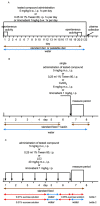Effects of GPR18 Ligands on Body Weight and Metabolic Parameters in a Female Rat Model of Excessive Eating
- PMID: 33809564
- PMCID: PMC8002110
- DOI: 10.3390/ph14030270
Effects of GPR18 Ligands on Body Weight and Metabolic Parameters in a Female Rat Model of Excessive Eating
Abstract
GPR18 has been proposed to play a role in the progression of metabolic disease and obesity. Therefore, the aim of this study was to determine the effects of selective GRP18 ligands (the antagonists PSB-CB5 and PSB-CB27 and the agonist PSB-KK1415) on body mass and the development of metabolic disorders commonly accompanying obesity. Experiments were carried out on female Wistar rats. In order to determine the anorectic activity of the investigated ligands, their effect on food and water intake in a model of excessive eating was assessed. Lipid profile, glucose and insulin levels as well as alanine aminotransferase, aspartate aminotransferase, and γ-glutamyl transpeptidase activity in plasma were also evaluated. Potential side effects were examined in rat models of pica behavior and conditioned taste aversion. Animals treated with different ligands gained significantly less weight than rats from the obese control group. Effects of GPR18 antagonists on food intake and body weight were specific and unrelated to visceral illness, stress or changes in spontaneous activity. However, the GPR18 agonist is likely to affect body weight by inducing gastrointestinal disorders such as nausea. The presented preliminary data support the idea that the search for selective GPR18 antagonists for the treatment of obesity might be promising.
Keywords: GPR18 ligands; PSB-CB5; anorectic activity; excessive eating model; palatable diet.
Conflict of interest statement
The authors declare no conflict of interest.
Figures







References
-
- Adel Y., Alexander S.P.H. Neuromolecular Mechanisms of Cannabis Action. Adv. Exp. Med. Biol. 2021;1264:15–28. - PubMed
Grants and funding
LinkOut - more resources
Full Text Sources
Other Literature Sources

